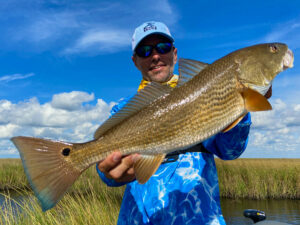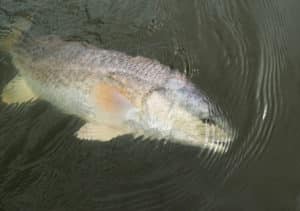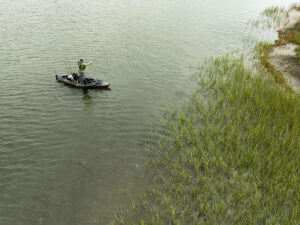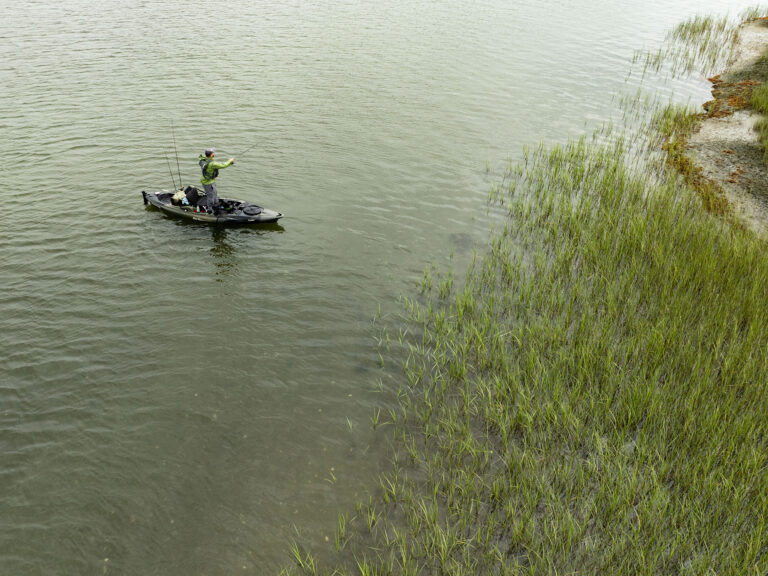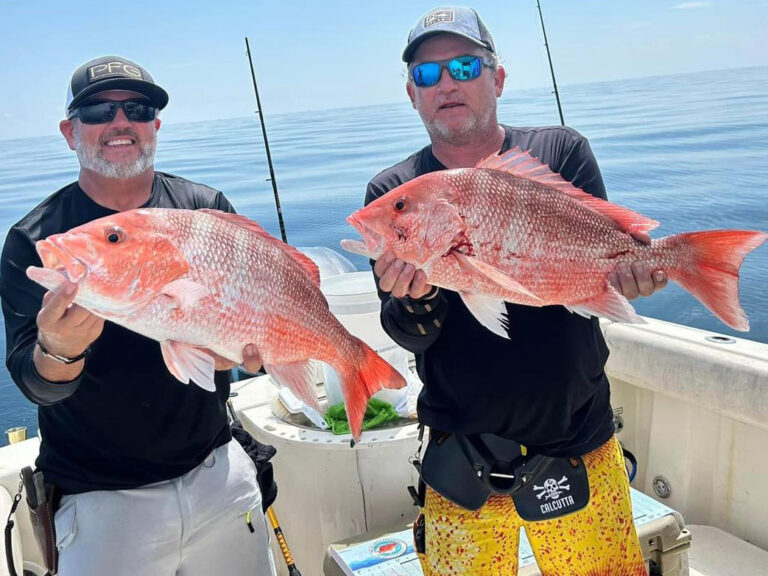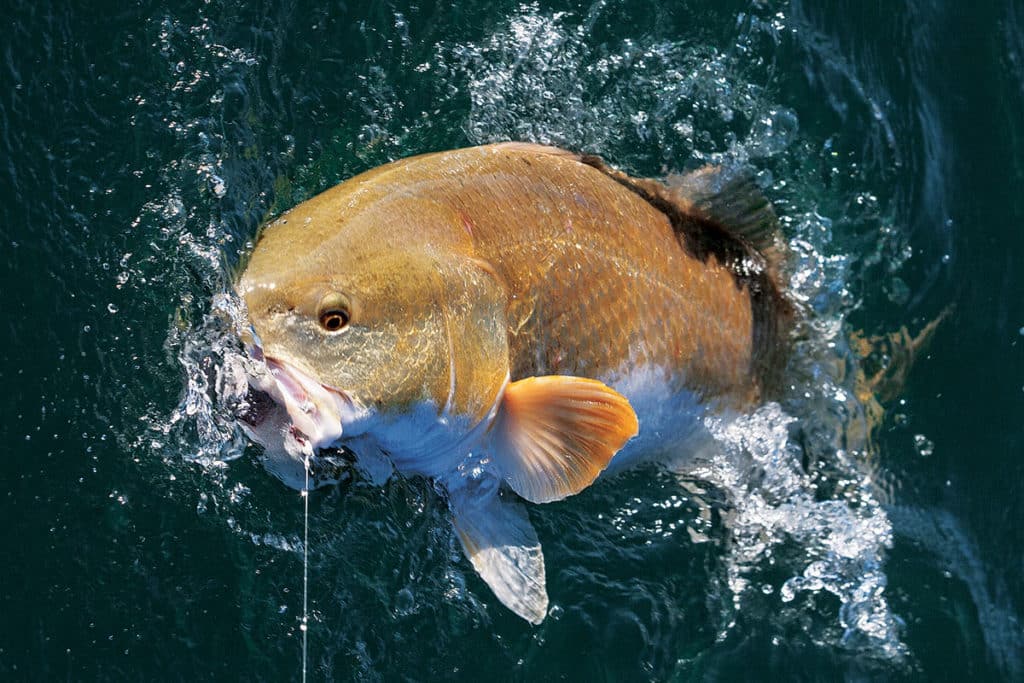
Leave the micro-skiff at home and keep the light-tackle outfits in the garage. If you want to catch bull redfish, think deep water and make sure to bring out the big guns.
The differences between adult and puppy red drum are so vast, you might as well treat the two like different animals. You’ll need to if you want to catch bull reds. Adult redfish lose their endearing adolescent spots, replaced with armor for scales and a caricature mouth only a carp could love. Their demeanor is bullish, using current and mass to fight down-and-dirty. And their meat turns from refined to tough, mirroring their aggressive mentality.
Bull redfish are the “big uglies” TV football commentators always talk about. Although “big ugly” is truly a nickname for a different drum — the black drum. Want to know how to catch these red drum? Conquering them requires sound technique, strength, specialized tactics and a keen eye. Learn how some of the best bull-beaters in the biz stay on top of their game.
Where to Catch Bull Redfish
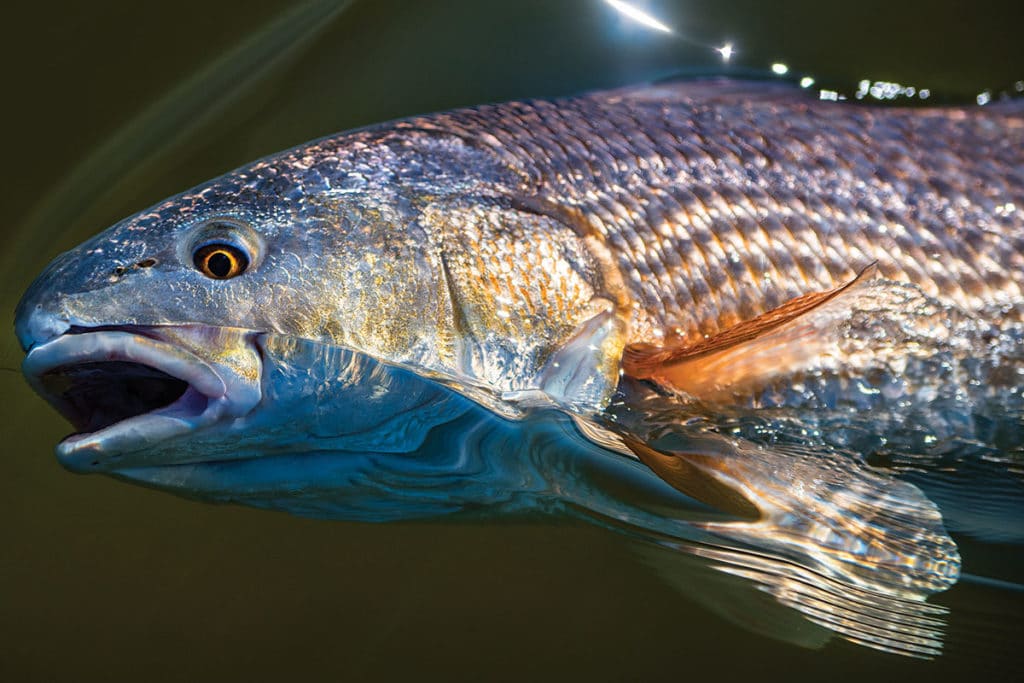
Bull redfish inhabit waters from Chesapeake Bay through the Gulf of Mexico, making this illustrious species readily available to huge numbers of anglers. Their pervasiveness is outstanding but requires anglers to understand local population habits.
In the Chesapeake, May through September is the optimal time to target big reds in nearshore waters. Giant reds school up in spring outside Hatteras and Ocracoke inlets before moving into Pamlico Sound for the summer spawning season. In fall, those same reds leave en masse and stay along the beaches until water temperatures plummet, pushing them offshore for winter. The Cape Lookout fall run lasts into December and sometimes all through a mild winter.
In Florida, northeast bull redfish start spawning in deeper sections of the St. Johns River during the first big moon in August. In the Gulf, Tampa anglers head to deeper waters near Fort Desoto, off St. Pete, next to the Skyway Bridge and near Egmont Key in fall and early spring. Florida Panhandle action starts right around Halloween and lasts all the way to February, with the most productive time in November and December near the beaches. These large schools of redfish can even be found off the coast of Louisiana and Texas, and range from 500 to 5,000 fish.
Your fishing location will dictate the season to fish, but once you’ve figured out when, and a general where, the task turns to locating the red drum schools.
Find the Hot Spot for Bull Redfish
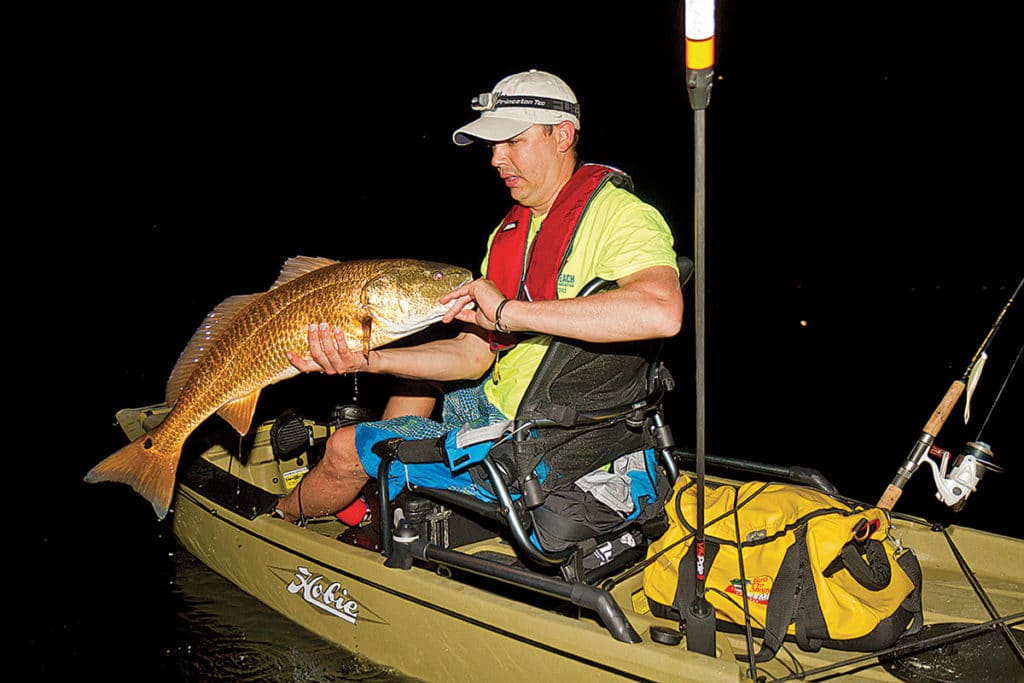
Locating bull redfish can be difficult, so consider every tool in your arsenal.
“Sometimes I’ll look for indicator species such as cownose rays to lead me to schools of redfish,” says Capt. Tyler Nonn, of Chesapeake Bay, Virginia. “After the fish move out of their early-season patterns, anglers can bottomfish outside the inlets, shoals and ledges in up to 50 feet of water.”
Concentrations of menhaden near drop-offs and ledges of a shoal are a good sign to look for on your bottom machine, especially at the mouth of the Chesapeake. Later in the year, fish can be marked on bottom machines under and around schools of small bluefish or spinner sharks.
“Red drum have a very unique signature, much like amberjack,” says Capt. Brian Horsley, of Oregon Inlet, North Carolina. “They will show on your bottom machine as layers, and sometimes they’ll mark diagonally. Deep reds are difficult to target; most anglers actually find them while fishing for something else.”
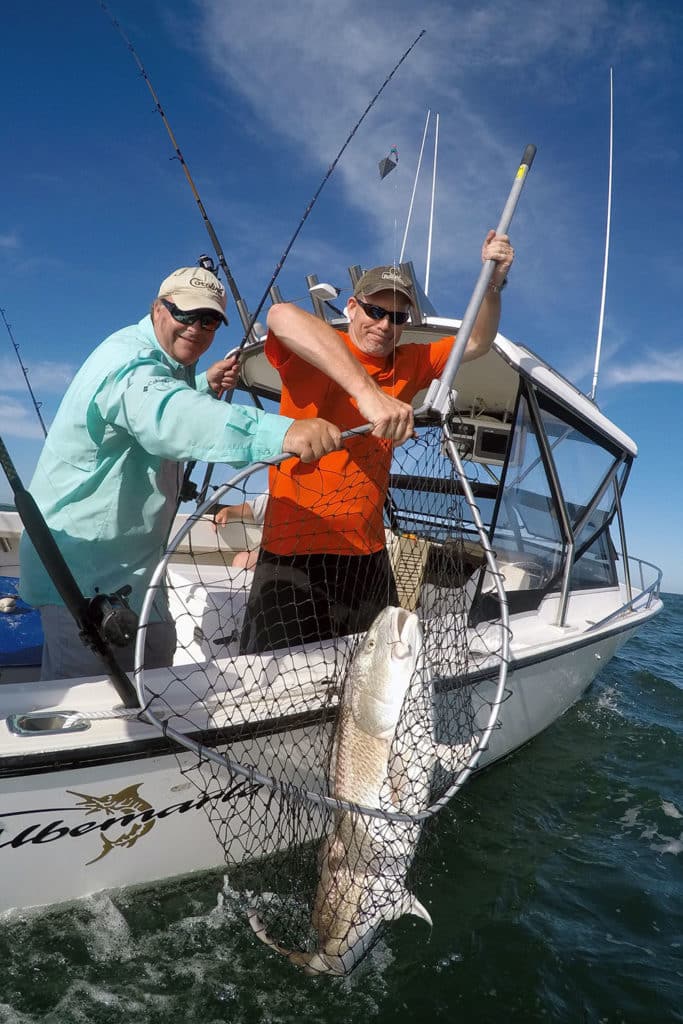
I had my first run-in with Panama City Beach bull redsyears ago during a paddle-craft media event. Only a few of us had ever fished off the beaches in kayaks, and we were content to target red snapper and groupers with metal flutter jigs. After gathering over good marks on the bottom machine, we dropped down quickly to see what was there. To our surprise, all three of us soon landed 20-plus-pound red drum. That’s when I learned that if you can find the reds bunched up, they’ll eat just about anything.
Redfish in the Panhandle and Tampa areas start to show in strong numbers only when the water temperatures hit the mid-60s, says Capt. John Rivers, who’s fished both areas extensively but now guides in Tampa.
“One easy way to find bull reds is to look for birds diving on the large schools of baitfish that the redfish have pushed to the surface,” says Rivers. “Another way is to have a reliable bottom machine with side imaging that can mark fish when there’s no surface activity.”
In Jacksonville, Capt. Kirk Waltz searches the mouth of the St. Johns River as far upriver as EverBank Field (home of the Jaguars) downtown.
“I begin my search by watching the bottom recorder for distinct breaks on the edges of deep water adjacent to the shipping channel,” says Waltz. “These bottom-contour changes look almost like offshore ledges but can also be sloping drops from deep to shallow water.”
Waltz believes the reds use ledges to block current to conserve energy but also to provide ambush spots as bait washes overhead. Most of these spots are from 29 to 46 feet deep.
Best Lures and Baits for Bull Redfish
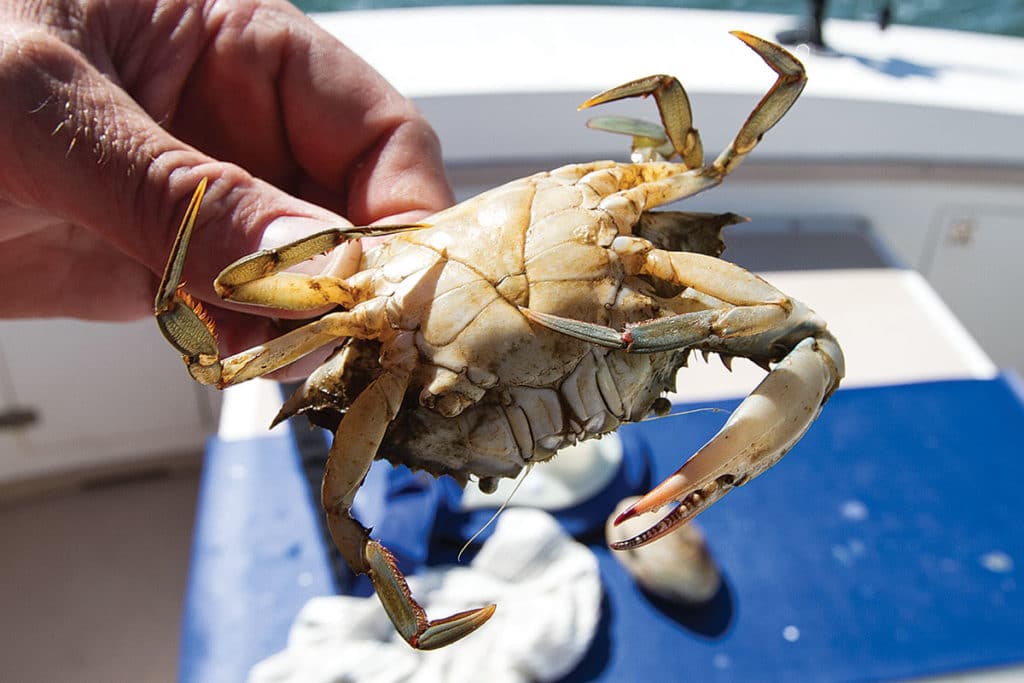
Your redfish tackle can make all the difference. The closest thing to a guaranteed bite, especially after locating fish, is to bait with fresh bunker or blue crab on the bottom. Terminal tackle is a simple three-way swivel system — the same rig many anglers use to bottomfish offshore — using 60- to 80-pound fluorocarbon, a 5/0 to 7/0 circle hook and a loop to interchange bank sinkers from 6 to 10 ounces.
“I like fresh blue crabs, mullet, pogies or ladyfish chunks,” says Waltz. “Chumming can be very effective. I like to find a spot and deploy four rods using two different baits to see what their preference is. A good soak of 15 to 30 minutes is preferred to allow the scent track to feed back in a light current.”
For the best redfish lures, captains Horsley and Rivers both prefer bucktails ranging from 1 to 8 ounces. “When they are schooled up, they are not too smart and will eat just about anything in their face,” jokes Horsley. Rivers dresses his bucktails with plastics. “I’ll use a 1½-ounce Spro bucktail jig in white, pink or chartreuse with a 4-inch soft-plastic tail,” he says. “Some guys use a plain 1-ounce jig rigged with a 7-inch curly tail.”
What’s the best bull redfish rod and reel? A 7-foot heavy-action rod paired with a 6,000-plus-class spinning reel, spooled with 50-plus-pound braid, is a great setup for any situation in which an angler will encounter bull redfish. Nonn prefers Shimano reels with PowerPro braid, while Waltz uses Penn reels with Berkley braid.
“If the fish are finicky and won’t touch jigs or dead bait, cast out a live bait rigged on a 3/0 circle hook and 40-pound fluoro,” says Rivers. “The [minimalistic] rig catches fish when nothing else will around Tampa Bay.”
Topwater Lures for Bull Redfish
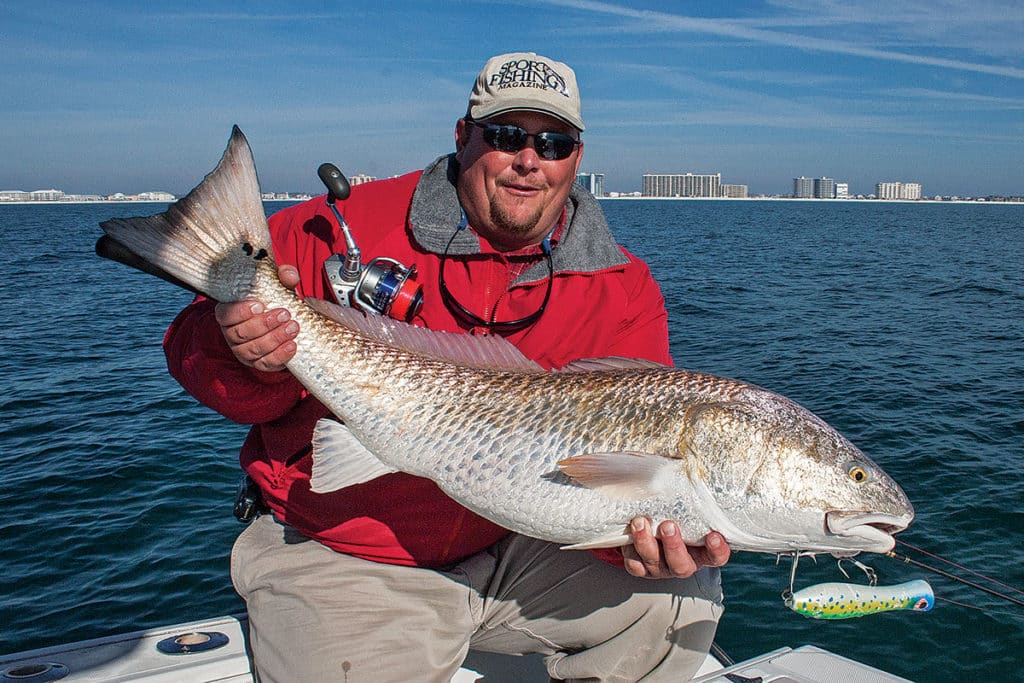
When conditions are right, large schools of reds will hang at the surface in deep water. Each captain I spoke with encountered this behavior, so it’s not location specific.
“When an angler finds an aggregation on top, it’s best to pick off fish from outskirts of the school and try to keep the boat away to avoid putting them down,” says Capt. Tyler Nonn. “Doubles and triples are real possibilities.”
Nonn will cast large soft plastics, such as Hogy Lures, while Horsley and Rivers prefer to work loud surface poppers. “As long as the birds aren’t diving around the large schools, it’s a blast to watch reds fight over and try to smash your plug,” says Rivers.
One sign that bull redfish are around but not necessarily at the surface is the presence of mud balls.
“Reds are famous for attacking schools of bait on the bottom during the spring, and are easily detected by the huge muds under the bait pods,” says Capt. Kirk Waltz. “Catch a few baits from the edges of these schools, and flip them back into the mud balls for quick hookups.”


